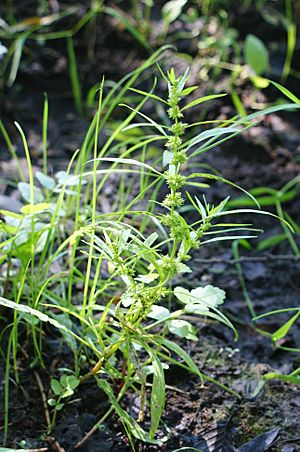Marsh dock facts for kids
Rumex palustris, also known as marsh dock, is a type of plant found mainly in Europe. It's a dicot, which means its seeds have two main parts. This plant belongs to the Polygonaceae family. Its name, palustris, comes from Latin and means "of the marsh," which tells us where it likes to grow!
Quick facts for kids Marsh dock |
|
|---|---|
 |
|
| Scientific classification | |
| Genus: |
Rumex
|
| Species: |
palustris
|
Contents
What Does Marsh Dock Look Like?
Marsh dock is an herb that can live for different amounts of time. Some plants live for just one year (annual), some for two years (biennial), and others for many years (perennial). Its stem grows upwards and has a few tiny hairs. The stem is usually less than one meter (about 3 feet) tall.
The branches and leaves grow in an alternating pattern along the stem. The leaves at the bottom of the plant are shaped like a lance, wider in the middle and pointy at the end. The leaves on the stem are also lance-shaped. Its flowers grow in groups, forming reddish-brown clusters. The plant's root is wider in the middle and gets thinner towards its tip.
How Marsh Dock Got Its Name
The name for this plant was first mentioned by Leonard Plukenet. He based it on a plant collected by Isaac Rand. The official scientific description of Rumex palustris was made by James Edward Smith. He wrote about it in his book "Fl. Brit." in 1800.
Types of Marsh Dock
There are a few different kinds of marsh dock, called subspecies:
- Rumex palustris uliginosus
- Rumex palustris maritimus
Where Does Marsh Dock Live?
Marsh dock loves wet places! You can find it in wetlands like damp meadows, marshes, and along the edges of lakes and streams. It is originally from Europe, especially in the southeastern and middle parts of the continent. This plant was also brought to America. Now, it grows in places like California and New Jersey.
Why Is Marsh Dock Special?
Rumex palustris is used as a "model organism" for scientific research. This means scientists study it to learn more about plants in general. Many studies focus on how marsh dock survives floods. It has a special way to grow taller when it's underwater.
When a marsh dock plant gets flooded, its leaf stalks (called petioles) can stretch out. This helps the leaves reach above the water's surface. This amazing ability helps marsh dock live in its wet home. Scientists are studying this plant to understand how plants can resist stress, like too much water.
See also
 In Spanish: Romaza de laguna para niños
In Spanish: Romaza de laguna para niños

